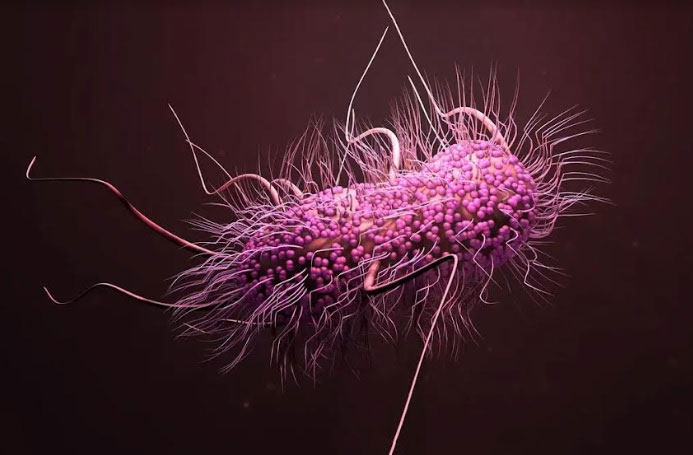Antibiotics 'transform' themselves - New weapon against drug resistance
Scientists recently created a new 'weapon' against drug-resistant super bacteria - an antibiotic that can change shape.
According to a study published in the scientific journal Proceedings of the National Academy of Sciences on April 3, scientists said they tested self-changing antibiotics in Galleria mellonella moth larvae. . This is a common animal model used to test the effectiveness of antibiotics in research.

Graphic image of an antibiotic-resistant superbug. (Photo: Live Science)
To create new antibiotics, researchers used 'click chemistry'. Click chemistry is a type of reaction where small molecules bond together to form large molecules, the molecules will only react with each other and cannot be reversed. This method is applied in DNA sequencing and materials science technologies, is high yield and clean, does not produce many unwanted byproducts.
Under the guidance of K. Barry Sharpless, one of the 'fathers' of click chemistry who won the prestigious Nobel Prize in Chemistry, the main author of the study - Professor John Moses works at the Laboratory Cold Spring Harbor (CSHL) in New York (USA) has successfully applied it to create an antibiotic that can change the arrangement of atoms and change shape.
Professor Moses came up with the idea of shape-shifting antibiotics when observing how tanks worked during military training exercises. With its rotating turret and agile movements, the tank can react quickly to possible threats.
Essentially, the new antibiotic combines an existing antibiotic called vancomycin with the molecule bullvalene . According to CSHL's conclusion, the bullvalene molecule, which serves as the 'core' of the antibiotic, can easily swap the positions of atoms and arrange them into more than a million different configurations. Meanwhile, the two ends of the antibiotic vancomycin will attach to the bullvalene 'core'.
Dr. Josh Homer, co-author of the new study, describes the bullvalene 'core' as acting like a Rubik's cube that can change shape. 'When attaching two vancomycin units to the Rubik's Cube in the middle, these vancomycin units can freely move around to protect the outside space,' expert Josh explained.
Vancomycin is a powerful antibiotic used to treat serious infections caused by gram-positive bacteria. To kill these bacteria, antibiotics will bind to the bacterial cell wall and weaken it, causing substances inside the bacterial cell to leak out and the bacteria will be destroyed.
Unfortunately, many types of bacteria have developed resistance to vancomycin, including vancomycin-resistant enterococci (VRE) . According to data from the US Centers for Disease Control and Prevention (CDC), in 2017, about 54,500 hospitalized infections and an estimated 5,400 deaths were caused by VRE cocci.

The World Health Organization (WHO) considers antibiotic resistance among the top 10 public health threats.
In the new study, when moth larvae were not treated, the mortality rate within 1 week of VRE infection was 90%. Next, when they were given a standard dose of vancomycin, the moths' one-week survival rate increased from 10% to 40%. Finally, when they were treated with the new shape-shifting antibiotic, the survival rate increased to 70%.
Compared to regular vancomycin, the shape-shifting antibiotic can create more tools to kill bacteria, researchers say.
Professor Moses explains: 'We discovered that the shape-shifting antibiotic has a mode of action that involves a reaction with a key enzyme in cells called MurJ. This enzyme transports energy from inside the cell to the cell wall, helping bacteria multiply, causing more severe infections.
Notably, according to the research team's analysis, the shape-changing antibiotic does not help VRE bacteria become resistant to the drug. Normally, increased exposure to antibiotics will help bacteria select new ways of resisting drugs, thereby increasing their ability to survive.
By self-changing shape, new antibiotics can find the optimal configuration to bind to the bacterial cell wall, forming a 'surround ' so they cannot escape.
According to Professor Moses, although the research is only in the early stages, has not been tested on humans and the level of effectiveness still needs to be researched, one thing is certain because bacteria have never encountered mutated antibiotics. change their previous form, so these drugs will cause some degree of chaos in the bacteria's working mechanism.
In the US alone, drug-resistant bacteria and fungi infect nearly 3 million people each year and kill about 35,000. Antibiotics are essential and effective, but in recent years, overuse has led to some bacteria developing resistance to them. Infections become very difficult to treat.
This problem is even more serious in developing countries, where the incidence of infectious diseases is high and access to antibiotics is often limited. The World Health Organization (WHO) has considered antibiotic resistance among the top 10 global public health threats.
Professor Moses concluded that with click chemistry, researchers can create countless new drugs. These antibacterial ' weapons ' will be the key to human survival and evolution.
- How to use antibiotics for safety
- Bad habits of parents hurt the liver and kidneys, endanger children
- The golden age of antibiotics is over, the immediate future will be a nightmare for humans
- Bacterial alarms resistant to many antibiotics
- New breakthrough in the fight against drug resistance
- How did bacteria learn to fight antibiotics?
- 7 principles when using antibiotics
- Antibiotics from dirt
- Antibiotic resistance can be passed from mother to child
- Three types of antibiotics defeat the most dangerous drug resistance gene of the virus
- Understand disease to use antibiotics correctly
- Increasing popularity of new drug-resistant TB strains
 The United Nations' all-human warning: All antibiotics are becoming useless
The United Nations' all-human warning: All antibiotics are becoming useless How did bacteria learn to fight antibiotics?
How did bacteria learn to fight antibiotics? 10 million deaths are one of the startling numbers about 'Antibiotic resistance'.
10 million deaths are one of the startling numbers about 'Antibiotic resistance'. 7 principles when using antibiotics
7 principles when using antibiotics